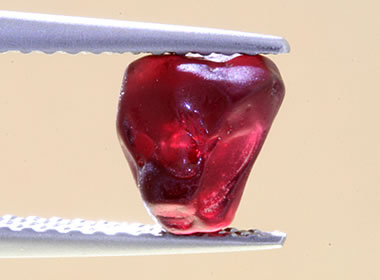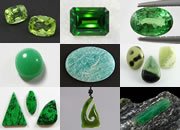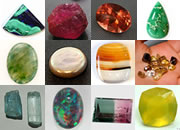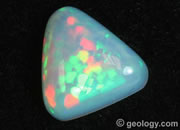Home » Gemstones » Ant Hill Garnet
Ant Hill Garnet
Tiny ants mine some of the best garnets. :-)
Author: Hobart M. King, PhD, GIA Graduate Gemologist

Faceted ant hill garnet: An "ant hill garnet" with spectacular body color from Garnet Ridge, near Dinnehotso, Apache County, Arizona. This stone is a 7.6 x 5.7 millimeter oval, weighing 1.02 carats. Ant hill garnets larger than one carat are unusual. Photograph by Bradley J. Payne, G.J.G., of TheGemTrader.com.
What are Ant Hill Garnets?
Some gemstones derive a large portion of their appeal because they are found in an unexpected locality or have an unusual origin. "Ant hill garnets" are one of the more interesting of these "novelty gems."
They are called "ant hill garnets" because they are found on and around the margins of ant hills. The ants encounter the garnets while excavating their underground passages. The ants haul the stones to the surface and discard them. The rain washes the garnets clean and moves them down the flank of the ant hill, where they can accumulate in large numbers. This concentrates the little gems and makes them easy for people to collect. Their brilliant luster and red color contrasts strongly with the surrounding soil.
Table of Contents
 What are Ant Hill Garnets? What are Ant Hill Garnets? Arizona Ant Hills Arizona Ant Hills Ant Hill Garnets as Diamond Indicators Ant Hill Garnets as Diamond Indicators |

Ant hill garnet rough: A specimen of ant hill garnet faceting rough from the Four Corners area of Arizona, under strong lighting to show its intense ruby-red color. This piece of rough weighs about 1.5 carats.
Arizona Ant Hills
A few areas in Arizona are well known for ant hill garnets. These are beautiful bright red chromium pyrope garnets with a very high color saturation. The Native Americans discovered them long ago and marveled at their color and beauty. They regarded them as special and sometimes sewed them into ceremonial rattles or gave them as tokens of appreciation.
Today, Native Americans and rockhounds collect the garnets and sell them in parcels to lapidaries who cut them into cabochons and faceted stones. The finished stones and attractive pieces of rough are sold to gem collectors and mounted into jewelry. The novelty origin of the stones adds to their appeal and can elevate their price to a higher level than what is paid for similar-quality stones from other localities.
The typical ant hill garnet is a tiny stone - almost always less than one carat when cut into a cabochon or faceted stone. The ants are smart enough to excavate around larger stones rather than haul them to the surface. This small size can actually be a blessing because many of the stones have a very high color saturation. If they were larger in size, the stones would have a very dark, almost black appearance; but in small sizes, enough light passes through them to reveal their desirable deep red color.
Ant hill garnets are novelty gems that mainly have a local popularity. The number of stones produced is far lower than what would be needed to make them a commercial gem, to be used in mass-produced jewelry with broad distribution.
Ant Hill Garnets as Diamond Indicators
Ants delivering small mineral particles to the surface is not unique to Arizona. It is known in many parts of the world. In a few instances, ant hill minerals have been used as a prospecting tool.
In prospecting for diamonds, geologists use "indicator minerals" to determine if they are on or near a kimberlite pipe - the host rock of many diamond deposits. The diamonds are brought up from the mantle by deep-source volcanic eruptions. There are often only a few carats of diamonds in many tons of kimberlite - but the kimberlite can be loaded with mantle-source minerals such as pyrope, garnet, and olivine.
So, instead of looking for diamonds, geologists look for these more abundant minerals to locate a pipe. Then they collect a bulk sample of the kimberlite to determine if the pipe contains diamonds. Geologists who do this type of work will often stop at any ant hill that they encounter to take a quick look for colorful bits of mantle minerals. The ants provide evidence of the geology below.
| More Gemstones |
 |
Birthstones |
 |
Diamond |
 |
Blue Gemstones |
 |
100+ Gems |
 |
Green Gemstones |
 |
Mined in America |
 |
Ruby and Sapphire |
 |
Ethiopian Opal |

Find Other Topics on Geology.com:

|

| ||

|

| ||

|

| ||

|

|
